Arunachal Pradesh, literally means “land of dawn-lit mountains”, is the north-easternmost state of India. It borders the states of Assam and Nagaland to the south. The culture of Arunachal Pradesh is truly varied in the sense that the state has 26 major tribes including sub-tribes. Every tribe has their own unique set of traditions and customs. Arunachal’s cultural lifestyle is dominated by colourful festivals. Since agriculture is the mainstay here so people generally celebrate festivals as a mark of thanksgiving to the Almighty for giving them a good harvest. These festivals also showcase the artistic skills of the various tribes.
Textiles
The textile patterns found among the tribes of Arunachal Pradesh such as Adi, Mishmi and Apatani are invariably of geometric pattern. Most popular motives are Zig-Zag lines and angular designs. The floral and Zemorphic patterns are more or less geometric form. The simple and straight lines, stripes and Aa bands and similar other patterns are most common. Contrasts and combination of colours are quite popular. The highly disciplined Adi and Apatani concentrate on simple straight line, while the strongly individualistic Mishmis go in for great celebration of pattern.

Mishmi: https://www.imcls.org/Encyc/2019/9/27/Idu-Mishmi-textile-Traditional-Cloths.html
The Adi have a great variety of straight forward patterns. There are arrangements of red and black strips on white ground, white and yellow strips on a black ground alternate bands of red and black ground, white bands of red and black or of olive green and brown, broad border-bands of brown with a central narrow strips of black and white and the body of the cloth being black with brown black and white strips at a three-inch interval.
The Gallong still continue the traditional design on the white clothes with broad rectangular design across the centre. The most popular Padam Minyong skirt is of crimson yellow colour with a vertical band which runs down the centre. The different varieties of bands and colour make the Apatani cloth different from that of the Gallong. The Mishmi weavings is however, more elaborate though the straight lines and bands are in use.
The colours and designs have their symbolic meaning among some of the tribes of Arunachal Pradesh. In Tuensang, the small red squares on a sanctum cloth are said to represent the ferment used in making beer. Shapely pointed triangles are arrows or horn bills. Circles of cowries stretched on a cloth symbolise human heads. The red colour of the shawls stands for the blood enemies, blue stand for the sky and black for the night.
The use of certain kinds of clothes and ornaments is often associated to a family’s social position and achievements in the fields of hospitality and war. The Apatani priests may wear special shawl on ceremonial occasion. This shawl with extraordinary design is said to have special supernatural power. One can know about the civil status of a girl from the type of belt she wears. The unmarried Adi girl wear one type of belt. Married women wear another. The Sherdukpens and Hrurso aristocracy alone can wear the Tibetan knobbed bat and in the past there were restrictions on the use of silk among the Monpas.
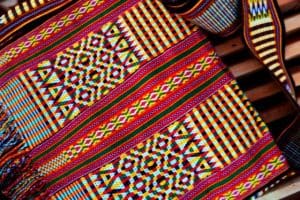
Monpas: https://www.pinterest.com/pin/66357794484401470/
The Wanchoos allow only members of the chiefs family to wear a certain type of blue head on the arms and legs and have special design for their head bands. In Tuensang the dress protocol has great importance specially because, in the past, man’s social position depended on his success in head-hunting and in giving feasts of merit.
Though there has not been much external influence on the design of the fabrics in Arunachal Pradesh, there has been some borrowing of motifs form the neighbouring areas. In western Kameng for example, the influence of Bhutan and Tibet is evident in many of the products of the Monpa loom. Monpa painting is largely Tibetan in subject and technique. Aeroplanes are now familiar objects all over the frontier and they appear in some recent Mishmi textiles.
Embroidery
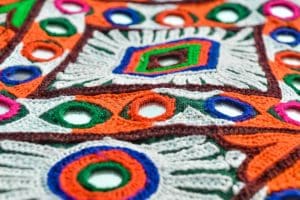
source: https://www.dreamstime.com/photos-images/tribe-woman-india.html
Embroidery of Arunachal Pradesh has earned its fame because of the versatility of creations by the artisans. The artisans of Arunachal Pradesh use an array of stitches that are used to decorate the items. The most important centres of embroidery work of Arunachal Pradesh are located in the Dumporijo Block regions and are admired for the creative excellence. The embroidery of Arunachal Pradesh is one of the main sources of income for different other communities. Today, even though embroidery is amongst the most traditional methods of decorating clothes, it is still as popular. Designs may date back to ancient times, or the modern geometric modern day designs, but all the same embroidery continues to be one of the common ways of decorating clothes. In fact, specialists feel that today, there is much more scope for creativity and innovation, because of the acceptance level.
This has ornamentation of tikris and beads, which make them, look attractive. This type of embroidery is done on a frame of wooden beams. The fabric is worked upon with a long needle, threads, tikris and beads. Multi sized frames are used, usually about 1.5 feet high, to secure the cloth on which the design is sketched with a stencil. One hand secures the thread under the cloth to the needle while the other hand moves the needle on top of the cloth with ease. Decorative tikris and beads are attached to the cloth with the needle.
Another embroidery pattern is the jaali or net embroidery in geometric or floral shapes and is done by pulling the warp and weft threads and fixing them with minute buttonhole stitches. The finished products dominantly comprise items for household use like curtains, bedspreads, furniture covers and dress material.
Costumes of Arunachal Pradesh
Arunachal Pradesh is a land of diversity with over 26 tribes and 100 sub-tribes. People here love their traditional costumes and are proud to showcase them on each and every occasion that comes across. Some favourites amongst all dresses include shawls, wraps and skirts. People who fall in love at first sight with colours and cultural diversity are the ones to enjoy this place the most. The most significant tribes of Arunachal Pradesh include Adi, Aka, Galo, Nyishi, Bori, Apatani, Bokar and Tangsa. Though the tribes share common ethnic but depending on the geographic region they belong to the dressing style also changes. Weaving is said to be in the blood of the natives of Arunachal Pradesh with Apatani tribe leading the lot with the capability to turn fibres derived from goat, human hair and trees to shawls, skirts, loincloth etc in numerous designs.
Sherdukpen Tribe
Men’s Clothing
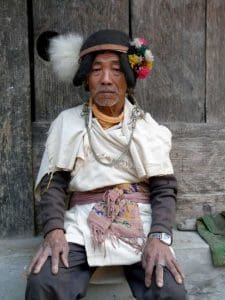
source: https://www.holidify.com/pages/arunachal-pradesh-dresses-186.html
They are natives of Bomdila and resemble the Monapas. Traditionally, a Sherdukpan male wears sleeveless silk material with its edges attached to the shoulder. The costume falls down till knee length. The look is complete only after a skull cap which has yak’s hair decorated on it is worn on top of the head.
Women’s Clothing
They wear collarless and sleeveless dresses till knee length. Along with this, a wear waist cloth along with a fully embroidered jacket having full sleeves is worn. Women make a bun on the backside of their head and have super-awesome weaving skills.
Tangsa Tribe
Men’s Clothing
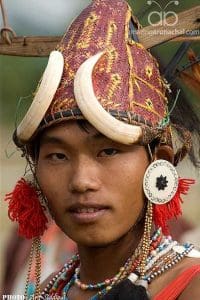
source: https://www.holidify.com/pages/arunachal-pradesh-dresses-186.html
This tribe wears costumes on similar lines to Burmese. The men wear green coloured wrap around spun in white, red as well as yellow coloured yarn. A sleeveless shirt along with an upper garment too is worn.
Women’s Clothing

source: https://www.holidify.com/pages/arunachal-pradesh-dresses-186.html
Women, on the other hand, wear a petticoat which is intricately woven and is extremely catchy to the eyes. Along with it, a linen blouse is worn too.
Miji Tribe
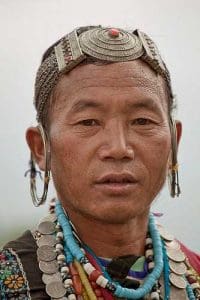
source: https://www.holidify.com/pages/arunachal-pradesh-dresses-186.html
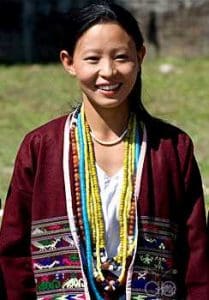
source: https://www.holidify.com/pages/arunachal-pradesh-dresses-186.html
The residents of Miji Tribe believe in keeping it simple which is why women inhabiting the districts of East and West Kameng put on outfits which are very simple but bring out their elegance. A long cloak is generally worn by them. Clothes without accessories are a waste. Therefore, the dress is accessorized with huge earrings and beautiful neck pieces.
Adi Tribe

source: https://thenortheasttravelblog.com/2013/07/30/adi-tribe-arunachal-pradesh-indigenous-peoples/
These people reside in the sub-tropical regions of Upper Siang, East and West Siang, Dibang Valley and Upper Subansiri. Because of the cool temperature in the region, men, as well as women, are required to wear jackets and woollen clothes so as to keep themselves warm. The clothes of both men as well as women are made out of deerskin, bearskin and cane skin.
Monpas
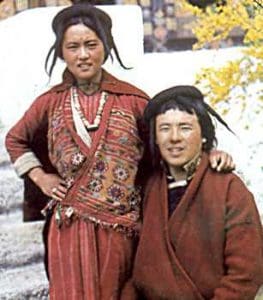
source: https://www.holidify.com/pages/arunachal-pradesh-dresses-186.html
This is a Buddhist community of Andhra Pradesh which is very famous for its skull cap. This skull cap is made up of laces and fringes. Women also wear sleeveless chemise paired with a long jacket. The chemise is tied to the waist by a long and narrow cloth so as to keep it in place properly.
Tribe of Lower Kamla Valley
The costumes worn by the people of this tribe are very attractive. Women tie their hair above their forehead in a knot. Crinoline of cane rings is the unique feature of female dresses of the region. These rings cover the upper part of the body and are an alternative to the use of blouse. However, as far as today’s scenario is considered, not many women can be seen sorting this kind of dress.
Aptani Tribe
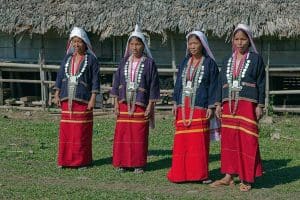
source: https://www.holidify.com/pages/arunachal-pradesh-dresses-186.html
Women’s Clothing
Women get a tattoo made which consists of blue stripes which are broad in shape and extend from head to the nose tip with five lined drawn vertically under the lower lip on the chin. The hair is neatly arranged on the top of the head into what is known as Dilling. Ading Akh which is nothing but a brass skewer is passed right across the Dilling horizontally.
Men’s Clothing
Traditionally, Aptani men make a knot of their hair on top of their forehead. This hairstyle is known as Piiding. A brass rod is used for creating the knot which is known as Piiding Khotu. Tattoos or Tiippe are applied by men on their chins.
Accessories

source: https://www.utsavpedia.com/attires/tribal-dresses-of-arunachal-pradesh/
Accessories enhance the value of clothes. Some of them which are worn very often during any wedding that takes place in the tribe include BiangSipi which is a chain comprising of blue-colored beads, BuahGatjiang which is a bead of red color tied on the wrist of the left arm of the groom, koktung which is a headgear, doumuiChe which is the sword of the bride, habo terri which refers to the garland worn by girls, pebar which is jewelry in the shape of a rectangle and talei which refers to the mixed size bowls.
People make hats with cane and bamboo along with beaks and feathers of birds.
Earrings and silver rings which are intricately designed with beads of various colours are a very popular accessory in the state of Arunachal Pradesh.
Art and Crafts of Arunachal Pradesh
Arunachal Pradesh is the home to a large number of tribes and sub-tribes. It has a rich tradition of craftsmenship, which manifests itself in various arts and crafts produced by these tribes. The Buddhist including Monpas, Sherdukpen, Aka, Bugun et al make beautiful masks, carpets and painted wooden vessels. The Bangis and Apatani make bag, hat, jewellery etc. Khamtis and Wanchos are well known for their wood carving. Pottery of Dafla women is well-known.
Ornaments
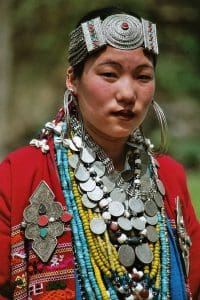
source: https://www.pinterest.com/pin/209558188885604179/
Ornaments making is a craft widely practised in Arunachal Pradesh. The work of a silver smith is more intricate and artistic. The first stage in the manufacture of the traditional ornaments he makes, is to make a wax mould of the ornament. This is done by warming the wax sticks or coils and then placing them on the standard moulds made of wax and wood. Where design are essential, they are made with thin wax coils and cut with a knife where necessary.
Wood-Carving
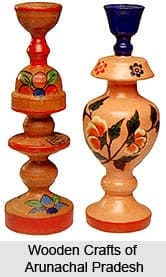
source: https://jnrglobetrotters.com/miscellaneous-art-and-crafts-of-arunachal-pradesh/
The tribes of Arunachal Pradesh also excel in the art of woodcarvings. The craft has been traditionally practiced for ages by the tribes. You would find some of the most excellent woodcarvings around the Wancho area of the Tirap district. Images of Lord Buddha, animal figurines, warriors and miniature of Morung are the most commonly found woodcarvings.
Bamboo and cane craft
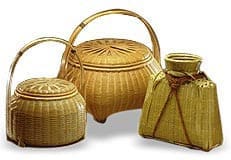
source: https://jnrglobetrotters.com/miscellaneous-art-and-crafts-of-arunachal-pradesh/
Bamboo and cane are extensively used in Arunachal Pradesh to make handicrafts and household utilities. The Arunachalis are expert craftsmen, who create some of the most exquisite artifacts using cane and bamboo.
Weaving

source: https://jnrglobetrotters.com/miscellaneous-art-and-crafts-of-arunachal-pradesh/
Weaving is also a very important industry in the households of Arunachal Pradesh. The Apatanis are the more skilled weavers among all tribes. Fibers made from bark of trees, hairs of goats and humans, besides cotton and wool are used in weaving.
Blacksmithy

source: https://jnrglobetrotters.com/miscellaneous-art-and-crafts-of-arunachal-pradesh/
Metal is mostly used by the tribes for making weapons and tools. The Machetes are expert blacksmiths, who make arrowheads, knives, iron bracelets as well as jewellery. Apart from this each tribe specializes in making a few particular products out of metal.
Pottery Crafting

source: https://jnrglobetrotters.com/miscellaneous-art-and-crafts-of-arunachal-pradesh/
Another area, which finds artistic expression in the life of the Arunachalis, is pottery. Some brilliantly designed products like vessels, vases and earthenwares, which are a collector’s item, can be found in the state of Arunachal Pradesh.
Carpet Making
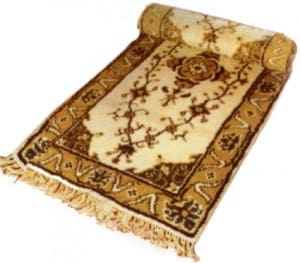
source: https://jnrglobetrotters.com/miscellaneous-art-and-crafts-of-arunachal-pradesh/
The carpet making is one of the important occupation in the districts of Tawang, West Kameng, Changlang, Upper Siang. The women folk are engaged in this trade.
Reference
https://en.wikipedia.org/wiki/Arunachal_Pradesh
https://www.webindia123.com/arunachal/arts/textiles.htm
https://www.arunachaltourism.com/culture.php
https://www.holidify.com/pages/arunachal-pradesh-dresses-186.html
https://jnrglobetrotters.com/miscellaneous-art-and-crafts-of-arunachal-pradesh/

Article Writtten By-
Ms. Sidrah Mubin Patel. B.Sc. in Textiles and Apparel Designing, Sir Vithaldas Thackersey College of Home Science.
Textile Value Chain Intern. Email: tvcmedia.digital@gmail.com

